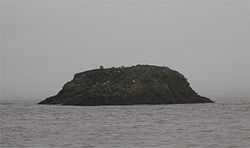Denny Island: Difference between revisions
Created page with "{{county|Monmouthshire}} thumb|250px|Denny Island '''Denny Island''' is a small rocky island of just over half an acre in the Severn Estuar..." |
No edit summary |
||
| Line 1: | Line 1: | ||
{{county|Monmouthshire}} | {{county|Monmouthshire}} | ||
[[File:Denny Island closeup.jpg|thumb|250px|Denny Island]] | [[File:Denny Island closeup.jpg|thumb|250px|Denny Island]] | ||
'''Denny Island''' is a small rocky island of just over half an acre in the [[Severn Estuary]] belonging to [[Monmouthshire]]. The island marks | '''Denny Island''' is a small rocky island of just over half an acre in the [[Severn Estuary]] belonging to [[Monmouthshire]]. The island marks the north-western limit of the city of [[Bristol]]'s water boundary in the Severn estuary.<ref>[http://www.bristol.gov.uk/ccm/content/press-releases/2007/sep/beating-bristols-water-boundary.en;jsessionid=10F98A2AB56BE787511AAAB782591A54.tcwwwaplaws1 Bristol City Council - Beating Bristol's water boundary]</ref> | ||
It is located approximately three miles north of [[Portishead]], midway between [[Redwick, Monmouthshire|Redwick]] and [[Avonmouth]]. It is surrounded by sandbanks known as the Welsh Grounds. Its foreshore area changes dramatically according to the state of the tide, because tides in the estuary and [[Bristol Channel]] are the second highest in the world, reaching 45 feet at the spring equinox. It is known as a nesting-place for gulls, cormorants and other seabirds, which are regularly seen and ringed there. | It is located approximately three miles north of [[Portishead]], midway between [[Redwick, Monmouthshire|Redwick]] and [[Avonmouth]]. It is surrounded by sandbanks known as the Welsh Grounds. Its foreshore area changes dramatically according to the state of the tide, because tides in the estuary and [[Bristol Channel]] are the second highest in the world, reaching 45 feet at the spring equinox. It is known as a nesting-place for gulls, cormorants and other seabirds, which are regularly seen and ringed there. | ||
| Line 18: | Line 18: | ||
[[Category:Bristol Channel]] | [[Category:Bristol Channel]] | ||
[[Category:Islands of Monmouthshire]] | [[Category:Islands of Monmouthshire]] | ||
[[Category:Islands in the River Severn]] | [[Category:Islands in the River Severn]] | ||
{{stub}} | {{stub}} | ||
Latest revision as of 14:23, 20 October 2015

Denny Island is a small rocky island of just over half an acre in the Severn Estuary belonging to Monmouthshire. The island marks the north-western limit of the city of Bristol's water boundary in the Severn estuary.[1]
It is located approximately three miles north of Portishead, midway between Redwick and Avonmouth. It is surrounded by sandbanks known as the Welsh Grounds. Its foreshore area changes dramatically according to the state of the tide, because tides in the estuary and Bristol Channel are the second highest in the world, reaching 45 feet at the spring equinox. It is known as a nesting-place for gulls, cormorants and other seabirds, which are regularly seen and ringed there.
History
Denny Island appears in the historical record for the first time as Dunye, in the charter recording the creation of the county corporate of Bristol in 1373.[2] This suggests that the name means, in Old English, 'island shaped like a down (i.e. a hill with a rounded profile)'. It gives its name to the Denny Island Fault Zone, a part of the Avon-Solent Fracture zone.[3]
References
- ↑ Bristol City Council - Beating Bristol's water boundary
- ↑ Harding, N. Dermott (1930). Bristol charters, 1155-1373 p 154-5. Bristol Record Society.
- ↑ Kellaway, G.A. (1996). "Discovery of the Avon-Solent Fracture Zone and its relationship to Bath hot springs.". Environmental Geology 28 (1): 34–9. doi:10.1007/s002540050076.
Outside links

This Monmouthshire article is a stub: help to improve Wikishire by building it up.